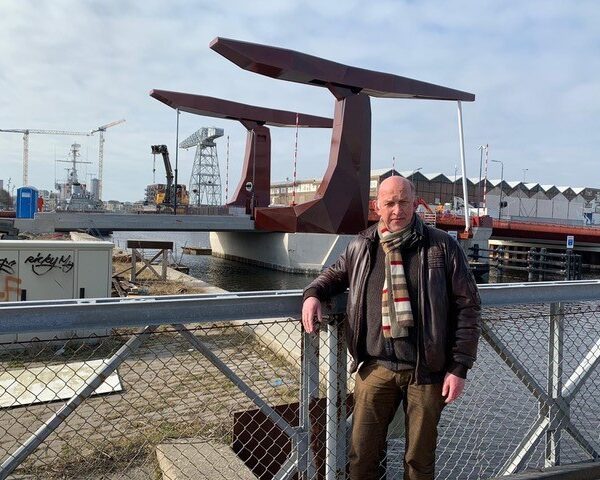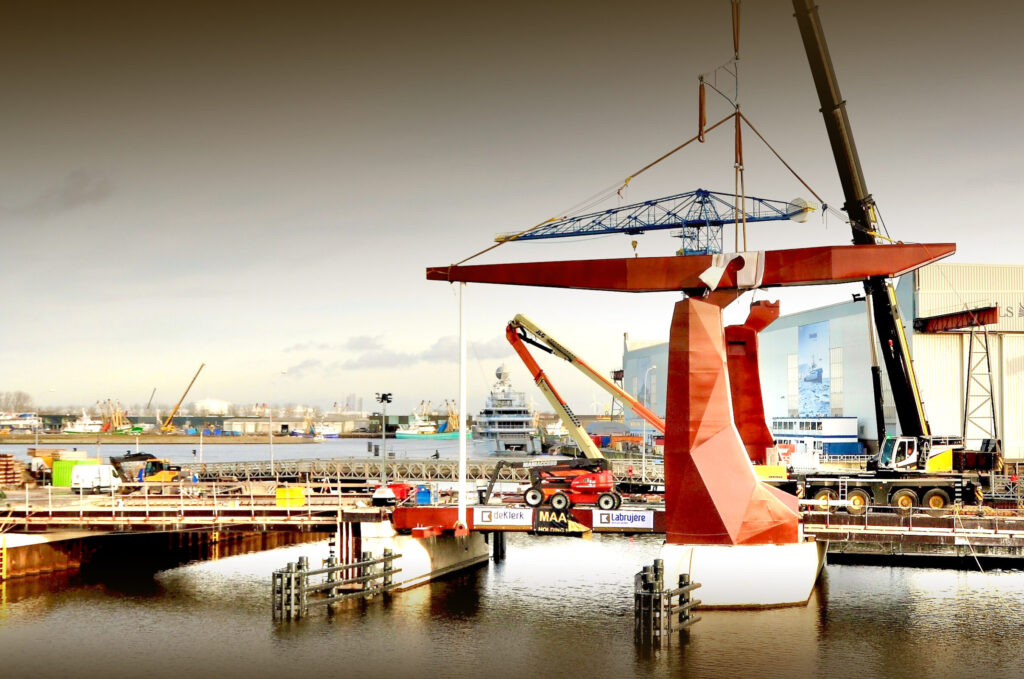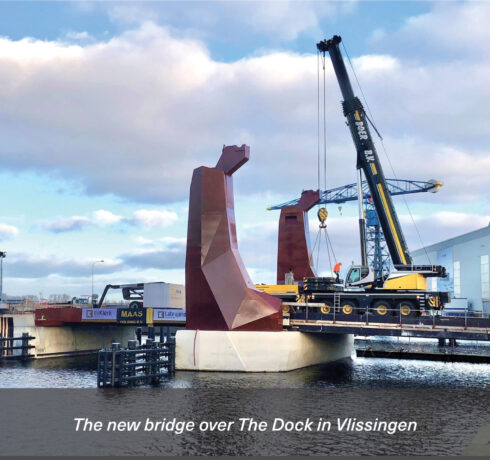 Municipality of Vlissingen Schelde Quarter Project Manager Hans van Houdt stands by the new double-beam drawbridge.
Municipality of Vlissingen Schelde Quarter Project Manager Hans van Houdt stands by the new double-beam drawbridge.
If all goes well, the new bridge over The Dock in Vlissingen will be ready for use on 1 May. The robust crossing to the former De Schelde terrain is set to be a real eye-catcher.
“The entire area that we purchased from Damen is now really starting to come to life; the new bridge is the pivotal part in that process,” says Hans van Houdt, who works for the municipality of Vlissingen as project manager of the Schelde Quarter. The Schelde Quarter is a thirty-two acre plot – the location of the former Royal Schelde Group shipyard – that is under redevelopment.
Employees of Damen Schelde Marine Services and Damen Yachting will no longer reach their workplace via the current temporary bridge, but from now on will use a brand new bridge (a double-beam drawbridge) called the Dokbrug. This replaces the temporary bridge thirty metres away.
“The temporary bridge really has seen better days,” says the project manager. “With the commissioning of the new bridge, the access road will also be shifted. People will no longer drive to the bridge via the front, but via the back of the Timmerfabriek.”
Hans is very proud of the result. “This new bridge symbolises the resurrection of the Schelde Quarter,” he explains. “Because of its colour, it also blends in very well with the surroundings. It has been painted in a dark metallic red, the colour of Corten steel, which is a nod to the area’s maritime past. The zware plaatwerkerij (sheet metal shop), for example, is also from Corten steel. In its day-to-day use, the new bridge represents a huge improvement compared to the temporary bridge. The Dokbrug will be able to open and close very quickly, whereas the current bridge sometimes took up to twenty minutes.”
In order to maintain optimal accessibility to Het Eiland (The Island), and the Damen and other companies located there, the Dokbrug will open a maximum of four to five times per day. This schedule has been discussed with the Koninklijke Schelde Groep (KSG), which manages the real estate concerns of the Damen companies based in Vlissingen.
The fact that the Dokbrug can open and close is because a new marina has been planned in the Dokhaven. Soon, pleasure yachts will be sailing to and from the marina via the new drawbridge.

The new bridge has been designed in such a way that it can carry very heavy transport, adds Hans. That was also decided in consultation with KSG. “The Dokbrug can handle loads of up to 100 tonnes and a maximum of 6x6x30 metres. In that respect, it is a heavy-duty and sturdy bridge. But at the same time it looks very slim. As mentioned, we have tried to make a bridge that matches the maritime character of the area, also a bridge with many surfaces, on which the light is constantly changing, evoking memories of the many cranes that once stood here.”
The construction of the bridge marks the creation of a new district of the city of Vlissingen, the basis for which was laid in 2004 with the transfer of the former De Schelde terrain to the municipality. Hans van Houdt: “There have been years when things have not gone smoothly, but the Schelde Quarter has now undergone a real transformation. The new Dokbrug – as the successor to a bridge that no longer worked – is the symbol of that transformation. We hear from all sides that Vlissingen is getting more beautiful; we also get many compliments from new residents. At this moment [10 February, ed.] there are 320 houses under construction here and all but 10 have been sold already. Twenty to thirty percent of the buyers come from outside the province of Zeeland. This shows how popular the area is.”
POETRY ON THE BRIDGE
When the bridge is open for passing waterborne traffic, road-users waiting to cross will be able to pass the time by reading a poem inscribed on the underside of the bridge deck. This was written by Vlissingen-based poet, illustrator and children’s book writer Wim Hofman.
WAAR ZIJN ONZE SCHEPEN?
HET GEBONK VAN HAMERS OP NAGELS
HET PONSEN VAN FLENZEN HET GERAKKETAK
HET WALSEN VAN PLATEN HET GERONK
VAN MACHINES HET GELUID VAN DE STOOMFLUIT
VAN KETTINGEN EN ANKERS DE FLES
DIE STUK SLAAT HET SCHIP DAT WEGGAAT
ALLES KOMT TERUG ALS IK WACHT BIJ DE BRUG
WIM HOFMAN 2020

